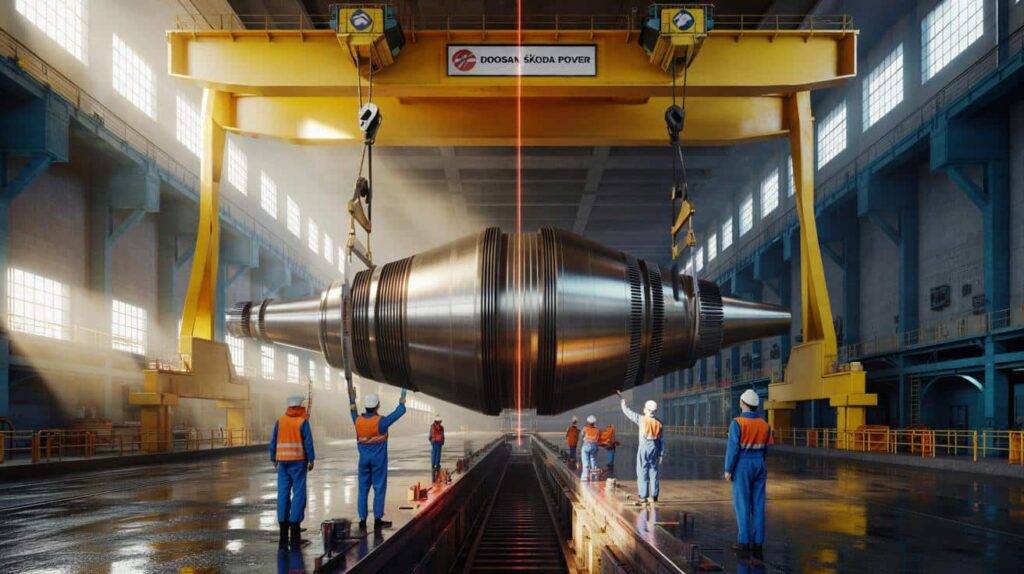In the Czech Republic, a nuclear power plant has just installed massive turbines that generate electricity like a coal facility—without the emissions. **Power increased, and the skyline remained unchanged.**
The turbine hall had a faint scent of oil and cold metal as the lift began. A rotor the length of a tram, shining silver, ascended so gradually that you could forget it was moving—until you felt the floor vibrate. Riggers communicated with two fingers and a wrist tilt, a kind of silent choreography that occurs when a hundred tons hangs above you.
One engineer couldn’t help but remark: “Heavier than a jumbo.” No one chuckled. A laser line sliced through the shaft, red and thin like a paper cut, as the crew adjusted the load by millimeters. Someone glanced at a watch; someone cleaned a foggy visor. And when the rotor touched the bearing, the hall went silent. More was on the way.
Inside the Czech upgrade that transforms steel into megawatts
Temelín, the largest nuclear power plant in the Czech Republic, has just replaced its low-pressure turbines with units designed to consume steam efficiently. The new assemblies—manufactured by Doosan Škoda Power in Plzeň—are not just large. They are precision-engineered sculptures of steel, with last-stage blades longer than a human arm and a rotor assembly that exceeds the empty weight of a Boeing 747.
Here, size is not just for show. It translates to output. With this replacement, Temelín’s two units gain approximately 110 megawatts of additional capacity in total, according to company data—about the output of a mid-size coal unit operating at full capacity. That’s sufficient to illuminate a city on a winter night, without emitting a single puff of smoke. Furthermore, since the upgrade focuses on enhancing efficiency in the steam path where energy is most easily lost, the increase occurs where it is most impactful.
The human element is more challenging to quantify, but it exists. Night shifts were precisely timed so that the country wouldn’t experience downtime. Precision alignment required tolerances of less than a millimeter, with new blade aerodynamics designed to extract more rotation from the same steam. The last-stage blades—approximately 1.2 to 1.3 meters—handle swirling, moist vapor at the very end of the cycle. Get that stage right, and suddenly every watt becomes cheaper.
What the numbers truly indicate when a utility claims “more power”
Here’s a straightforward way to interpret a headline like this: three metrics, one gut feeling. Look for net megawatts added (not just gross), the anticipated capacity factor, and the plant’s heat rate or efficiency improvement. If the utility states +110 MW combined and the plant operates most of the year, that signifies a substantial amount of coal or gas that no longer needs to be burned. The rest is just narrative.
People often get caught up in percentages and overlook the fundamentals. Net versus gross output can obscure 5–10% of the reality. So can neglecting how frequently the plant actually operates. We’ve all experienced that moment when jargon obscures the message. Think in terms of powered households, hours per year, and what gets displaced on the grid first. **That’s the quiet math that alters bills.**
There’s a rhythm to work of this nature. A retrofit introduces a heavier rotor, smarter blades, smoother bearings, followed by upgrades to moisture separation and digital controls that guide the turbine into a more optimal operating curve. That’s how you convert the same steam into additional electricity.
“You gauge success in millimeters and megawatts,” a Temelín engineer shared with me. “If we get both right, the country remains unaware—except that the air becomes a bit cleaner.”
- Plant: Temelín Nuclear Power Station (ČEZ), two VVER-1000 units
- Turbine supplier: Doosan Škoda Power, Plzeň
- Upgrade: New low-pressure rotors and last-stage blades (~1.2–1.3 m)
- Estimated gain: ~110 MW combined, net
- Impact: Output comparable to a mid-size coal unit, with zero emissions on site
Why it matters far beyond one hall of steel
Europe requires flexible certainty. Demand from data centers, electric vehicle charging, and heat pumps is rising, while weather fluctuations cause wind and solar to be inconsistent. Upgrades like this enhance a stable nuclear foundation, making it slightly larger and reducing peaks that would have been met by gas or coal. Fuel saved equates to carbon emissions avoided—and provides a buffer for winter.
There’s also a psychological shift involved. No ribbon-cutting, no new tower, just a more intelligent core operating within an old structure. It’s the kind of transformation that doesn’t seek attention yet pays dividends in kilowatt-hours day after day. Let’s face it: nobody truly reads turbine specifications over breakfast. But you notice the impact when the grid remains stable at 6 p.m. in January, and your bill doesn’t spike because a gas plant had to rush.
For the Czech Republic, it represents energy security wrapped in engineering pride. For neighboring countries from Poland to Austria, it serves as a model: maximize what you have with improved blades, better steam paths, and enhanced controls. **Small, precise upgrades can accumulate to national-scale power.** The future may not always involve constructing more. Sometimes it’s about optimizing what’s already operational to perform better.
What this means for you, me, and the next winter evening
You don’t need to be a turbine enthusiast to recognize what’s occurring. A nation has just discovered a coal plant’s worth of electricity within a facility it already possessed, utilizing steel it was already familiar with, and teams who live nearby. That’s not exaggeration. That’s craftsmanship. It also hints at the next decade: less drama, more incremental victories—measured not in headlines, but in stable grids.
Consider it a quiet agreement. Utilities can postpone some expensive new constructions, grids gain resilience, and households enjoy stability that’s difficult to express in a tweet. The climate benefits as well, every hour that the additional nuclear output replaces fossil fuel peakers. Share this with a friend who claims energy is dull. It’s not. It’s the difference between a flicker and a room that stays illuminated.
| Key point | Detail | Why it matters |
|---|---|---|
| Massive turbines installed | New low-pressure rotors and extended last-stage blades at Temelín | Converts the same steam into additional electricity |
| Coal-like boost without emissions | ~110 MW net added—similar to a mid-size coal unit | Increased power, reduced emissions in the grid mix |
| Precision equals reliability | Sub-millimeter alignment, upgraded controls | Enhanced efficiency and dependability during peak demand |
FAQ :
- Which plant installed the giant turbines?Temelín Nuclear Power Station in the Czech Republic, operated by ČEZ, with turbine upgrades by Doosan Škoda Power.
- How much extra power are we discussing?Approximately 110 MW combined across both units, based on company data—enough to match a mid-size coal unit.
- Do they really weigh more than jumbo jets?The new low-pressure rotor assemblies exceed the empty weight of a 747, which is why those lifts resemble moon landings.
- Will this make electricity cheaper?It can alleviate price pressure by reducing the need for gas or coal during peak times and by enhancing efficiency. The exact impact depends on market conditions.
- What about safety and waste?The upgrade does not alter the reactor core. It involves downstream hardware. Safety systems remain intact, and waste management adheres to existing national and EU regulations.








